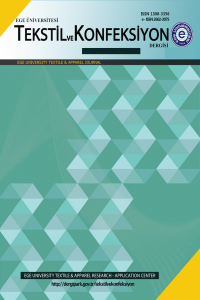NANOİZ TESTİ İLE PLASTİK OPTİK LİFLERİN ÖZELLİKLERİNİN İNCELENMESİ
HARDNESS PROPERTIES OF PLASTIC OPTICAL FIBERS BY NANOINDENTATION
Nanoindentation, Creep, Plastic optical fiber, Cross section Surface roughness, Hardness, Modulus,
___
- 1. Oliver W.C., Pharr G.M., 2004, Measurement of hardness and elastic modulus by instrumented indentation: Advances in understanding and refinements to methodology, Journal of Materials Research, Vol: 19(1), pp. 3-20.
- 2. Golovin Y.I., Iunin Y. L., Tyurin A.I., 2003, Strain-Rate Sensitivity of the Hardness of Crystalline Materials under Dynamic Nanoindentation, Doklady Physics, Vol: 48(9), pp. 505-508.
- 3. Ma Z.S., Long S.G., Pan Y., Zhou Y.C., 2008, Loading rate sensitivity of nanoindentation creep in polycrystalline Ni films, Journal of Materials Science., Vol: 43, pp. 5952-5954.
- 4. Briscoe B.J., Fiori L., Pelillo E., 1998, Nano-indentation of polymeric surfaces, J. Phys. D: Applied Physics, Vol: 31, pp. 2395-2405.
- 5. Pang J.J., Tan m.j., Liew K.M, 2012, Nanoindentation study of size effect and loading rate effect on mechanical properties of a thin film metallic glass Cu49.3Zr50.7, Physica B: Condensed Matter, Vol: 407(3), pp. 340-346.
- 6. Zubia J., Arrue J., 2001, Plastic Optical Fibers: an introduction to their technology processes and applications, Optical Fiber Technology, Vol: 7, pp. 101- 140.
- 7. Thiele E., Helbig R., Weigand F., Arnold R. Seeger M., 2009, Two ways to apply optical fibers in textile structures, T-Plot Workshop Technical Textiles and Textile Recycling.
- 8. Wang J.C., Yang B., Huang B.H, Jin Z.M., 2012, Design and development of polymeric optical fiber jacquard fabric with dynamic pattern display, Textile Research Journal, Vol: 82(10), pp. 967-974.
- 9. Křemenáková D., Lédl V., Militký J., Bůbelová B., Meryová B., 2013, Active illuminating safety product, Certified Product n. 24997, Patent office, Czech Republic.
- 10. Krebber, K., Lenke, P., Liehr, S., Witt, J. and Schukar, M., 2008, Smart technical textiles with integrated POF sensors, Proceedings of SPIE 6933, Vol: 69330 (5), pp. 1-15.
- 11. Lee S.H., Wang S.Q., Pharr G.M., Xu H.T., 2001, Evaluation of interphase properties in a cellulose fiber-reinforced polypropylene composite by nanoindentation and finite element analysis, Composites, Part A: applied science and manufacturing, Vol: 38, pp. 1517-1524.
- 12. Yang S., Zhang Y.W., Zeng K.Y., 2004, Analysis of Nanoindentation Creep for Polymeric Materials, Journal of Applied Physics, Vol: 95 (7), pp. 3655-3666.
- 13. Raman V., Berriche R., 1992, An Investigation of the Creep Processes in Tin and Aluminum using a Depth-sensing Indentation Technique, Journal of Materials Research, Vol: 7 (3), pp. 627-638.
- ISSN: 1300-3356
- Yayın Aralığı: Yılda 4 Sayı
- Başlangıç: 1991
- Yayıncı: Ege Üniversitesi
HAZIR GİYİM SEKTÖRÜNDE TÜKETİCİLERİN RENK TERCİHLERİNİ ETKİLEYEN FAKTÖRLERİN ANALİZİ: TÜRKİYE ÖRNEĞİ
Turan ATILGAN, Seher KANAT, Seda KULELI
BİR HAZIR GİYİM İŞLETMESİNDE KAYNAK KISITLI KARMA MODELLİ MONTAJ HATTI DENGELEME
TEK RENKLİ DOKUMA KUMAŞLARIN YAPISAL PARAMETRELERİNİN GÖRÜNTÜ İŞLEME YÖNTEMİ İLE BELİRLENMESİ
Ionut DULGHERIU, Manuela AVADANEI, Ciprian COZMANCIUC
YIKAMANIN DENİM GÖRÜNÜMLÜ ÖRME KUMAŞLARIN BOYUTSAL STABİLİTESİNE ETKİSİ ÜZERİNE BİR ARAŞTIRMA
Züleyha DEĞİRMENCİ, Nihat ÇELİK
KATLANABİLİR HAROŞA YAPILARIN SIKIŞTIRILABİLİRLİK ÖZELLİĞİ
Darja RANT, Ramona CIOBANU, Mirela BLAGA, Alenka PAVKO-CUDEN
ÇEK ERKEK VÜCUT ORANLARI VE ERKEK GÖMLEK KALIBI HAZIRLAMA METOTLARI ÜZERİNE BİR ARAŞTIRMA
Blazena MUSİLOVÁ, Renáta NEMČOKOVÁ
NANOİZ TESTİ İLE PLASTİK OPTİK LİFLERİN ÖZELLİKLERİNİN İNCELENMESİ
